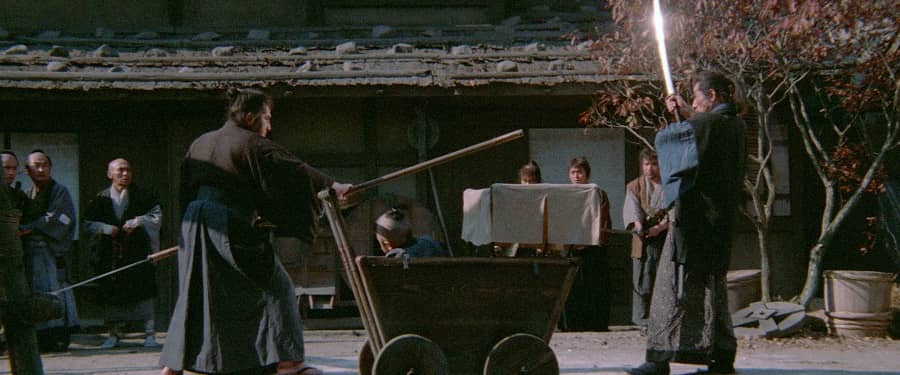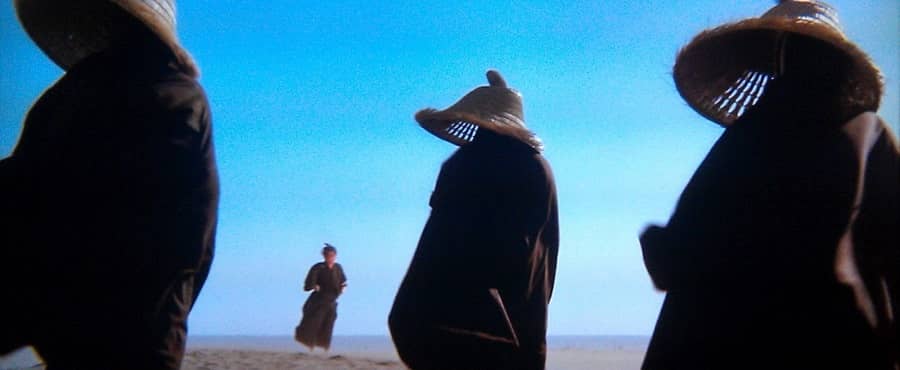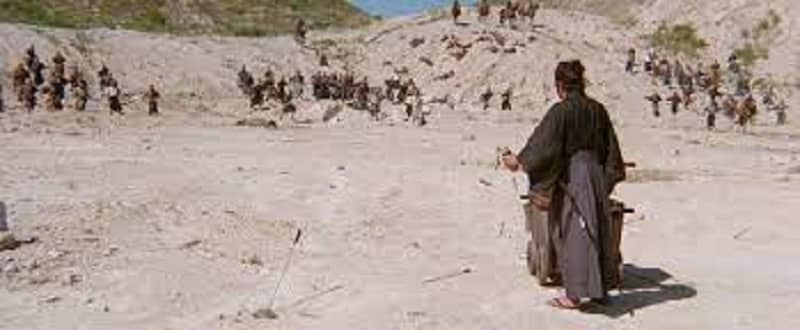Ellsworth’s Cinema of Swords: Lone Wolf and Cub, Part 1
Lone Wolf and Cub 1: Sword of Vengeance (Japan, 1972)
Lone Wolf and Cub, the celebrated samurai manga series by writer Kazuo Koike and artist Goseki Kojima, began in 1970 and, wildly popular, eventually ran to many thousands of pages and was adapted to both film and television. However, it was virtually unknown in America and Europe until 1980 when the compilation Shogun Assassin was released, drawing on the first two motion pictures. But Shogun Assassin emphasized the series’ brutal violence and was regarded by most in the west as trash cinema, a reputation that was unchanged until 1987 when the Lone Wolf and Cub manga series was finally republished in the US and UK by First Comics. With covers and endorsements by then-fan-favorite Frank Miller, the comics were widely acclaimed, and the movies finally found release in the United States and Europe in their original forms.
This week we’re taking a look at the first three Lone Wolf movies from 1972-73. Despite their level of gore and carnage, which was considered extreme at the time, these are serious films, adapted from the manga by Kazuo Koike himself. Their success is all the more remarkable because star Tomisaburo Wakayama, middle-aged and heavy, looks so little like a samurai matinee idol. But Wakayama had been a dedicated martial artist before he became an actor, and his surprising athleticism adds depth and credibility to the role.
Lone Wolf and Cub 1: Sword of Vengeance
Rating: ****
Origin: Japan, 1972
Director: Kenji Misumi
Source: Criterion Blu-ray
The manga series Lone Wolf and Cub, written by Kazuo Koike and drawn by Goseki Kojima, began publication in Japan in 1970 and was an instant success. Shintaro Katsu of Zatoichi fame decided to produce a series of films based on the stories, scripted by Koike himself, directed by Kenji Misumi, one of Katsu’s favorites, and starring Tomisaburo Wakayama, Katsu’s elder brother and a martial artist himself. Under the influence of Hong Kong wuxia films and reflecting the source material, the movies were more violent and bloody than the Zatoichi series and had more sexual content. Yet these were not mere exploitation films.
Under the Tokugawa Shogunate, the Shogun’s spy agency was run by the Yagyu clan, while the position of Shogun’s official executioner was an office held by the Ogami family. The film starts with Itto Ogami (Wakayama) performing his cruel duty with rigorous precision, taking the life of a two-year-old lord whose clan the Shogun had decided to dissolve. Itto then goes home to his wife and his own infant son, Daigoro, whom he loves and intends to raise in the rigid code of the samurai. However, the wicked Yagyu want to add the prestigious position of executioner to their own portfolio, so they assassinate Itto’s wife and frame Itto with a phony treason charge. He is ordered to commit seppuku.
But Itto is unwilling to die before having his revenge on the Yagyu and attempting to clear his name. He tests his tiny son by offering him two options: a gaudy ball and a shiny sword. If Daigoro chooses the ball, Itto will send him to the afterlife to join his mother — but he crawls to the sword, and Itto takes it as a sign that Daigoro should join him in the life of a fugitive assassin. When the Shogun’s officers, the Yagyu included, come to witness Itto’s self-suicide, he proclaims himself no longer bound by samurai law, cuts himself free with his sword in one hand and his son in the other, and disappears.
Two years later, Itto has become a masterless ronin, an assassin known only as Lone Wolf. Grim and ragged, he pushes a baby cart carrying three-year-old Daigoro while wearing a banner proclaiming himself as a sword for hire. He’s offered a job by the chamberlain of the Oyamada clan whose lord is threatened by traitors within: assassinate the leaders of the traitors and the ronin ruffians they’ve hired to attack the lord, gathering now at a remote hot springs resort. After hearing the chamberlain’s reasons for the job, Itto accepts.
The Lone Wolf is a grimly efficient assassin, but his Cub takes a child’s delight in the world and what it has to offer, and we often see things through his innocent eyes rather than his father’s: roadside flowers, children playing, the beauties of nature. Itto enters the resort as a simple traveler with a child, but the ronin who’ve taken it over are brutal thugs, raping and killing, so Itto shields Daigoro from seeing their worst excesses. And though the thugs take Itto’s executioner’s sword from him upon arrival, Daigoro’s cart turns out to contain a number of lethal, hidden weapons. The thugs, and the disloyal samurai who’ve hired them, don’t stand a chance.
Lone Wolf and Cub 2: Baby Cart at the River Styx
Rating: ****
Origin: Japan, 1972
Director: Kenji Misumi
Source: Criterion Blu-ray
This is even better than the first one: without the burden of recounting an origin story layered in flashbacks, writer Koike and director Misumi are freed up to tell a straightforward tale of one of Lone Wolf and Cub’s assassination missions. Well, as straightforward as such a tale can be when it includes Kurokuwa clan ninjas, Yagyu female samurai assassins, a burning ship as a nautical deathtrap, son Daigoro dangling over a bottomless well, naginata pole vaulting, knives concealed in daikon radishes, ambushers hiding under the sand in seaside dunes, and the Three Monks of Death.
Once again, Itto Ogami (Tomisaburo Wakayama) is approached by a clan chamberlain to perform an assassination, this time by the Awa clan who are trying to protect their indigo dye secrets from the Shogunate, who want to steal them and reap the profits for themselves. The Awa dye master, who hopes to defect, is in hiding, and Itto, after hearing all the “secrets and reasons” for the job, agrees to kill him. But the Yagyu clan are still after the former Shogunate executioner, and they detail their Akashi female killers, led by Lady Sayaka (Kayo Matsuo), to “use any means” to end Itto’s life. Sayaka is disdainful of employing dishonorable means to kill Itto, but the orders of Yagyu Lord Retsudo are explicit. So Sayaka sends wave after wave of her disguised killers after Itto, and he kills them all — even Daigoro gets in on it, loosing a spring-loaded blade from his baby cart. Finally, only Sayaka is left, and she escapes.
The Kurokuwa ninjas are equally unsuccessful, and the last of their number insists that Sayaka join them in a plot to distract Itto by abducting Daigoro. This they do while Itto is recovering from his ninja-inflicted wounds, but their threats to his son don’t deter him — Itto informs his opponents that he and Daigoro are on the Demon Road to Hell, and though they will fight to avoid death, they accept their destiny. Sayaka wavers — will she stand by and let Daigoro die?
There’s still that mission to accomplish: the Shogunate is sending three brothers, martial arts killers known as the Monks of Death, to collect the Awa defector and bring him to Edo. With their great wicker hats, they are a striking trio, and anyone looking for the visual inspiration for the Three Storms in Big Trouble in Little China (1986) need look no further. Each Monk of Death uses a different cruel weapon, and they slaughter about thirty Awa samurai in two mass ambushes before they have to face a more formidable opponent: Itto Ogami, standing alone waiting for them in the blowing sand atop a tall dune.
(This film, by the way, was the primary source for the notorious Shogun Assassin, the re-edited sensationalist Lone Wolf and Cub movie concocted by American director Robert Houston in 1980, covered separately.)
Lone Wolf and Cub 3: Baby Cart to Hades (or Lightning Swords of Death)
Rating: ****
Origin: Japan, 1972
Director: Kenji Misumi
Source: Criterion Blu-ray
Another fine entry in the series, with something for everyone, from the serenity of nature and its creatures, as seen through the eyes of young Daigoro Ogami, to the brutality of sudden death, as seen through the eyes of a rolling just-severed head.
On his wanderings with his son, Itto Ogami (Tomisaburo Wakayama) encounters disgraced samurai Master Kanbei (chambara heartthrob Go Kato), who is traveling with a band of lowly mercenaries. The mercs molest two innocent women, Itto and Kanbei come into the quarrel on opposite sides, and Kanbei formally demands a duel with Itto. Upon drawing their swords, the former executioner recognizes Kanbei’s qualities, and declares the duel a draw so that Kanbei will have the opportunity to live on as a “true samurai.”
After cutting down a few more vengeance-crazed ninjas, who jump out of the woodwork every time things slow down, Itto finds his next big assassination mission. He defends a country woman who’d been bought for a brothel and then killed her abusive pimp, which puts Itto in conflict with Torizo (Yuko Hamada), the hardboiled brothel mistress, who insists the young woman must suffer the traditional yakuza punishments. Itto demands to act as her proxy and suffer the tortures himself, which he does so stoically that he earns the admiration of Torizo. More importantly, she recognizes him as the assassin Lone Wolf, whom her father has been searching for.
Torizo’s father is a former officer of a fallen clan that was sold out to the Shogunate by Genba (Isao Yamagata), who now rules the clan’s lands as the Shogun’s governor. This villain also raped Torizo’s twin sister and drove her to suicide. Itto agrees to assassinate Genba and is able to get close to him, because Genba wants to hire the Lone Wolf himself to take out a rival. But Genba, with the insight of the paranoid, realizes that Itto has already been hired to kill him, and escapes.
Genba has a couple of colorful bodyguards whom he sends after Itto, a quick-draw swordsman and a gunman with twin American revolvers, but Itto dispatches them both, so Genba goes for quantity over quality, calling in favors to gather dozens of defenders, including the mercenary band that includes Master Kanbei among their membership. But Itto prepares for the encounter by outfitting Daigoro’s baby cart with some lethal new tricks, and Genba and his men are scythed down like wheat at harvest time. The last man standing is Master Kanbei, who once again demands a formal duel — and when Itto hears his reasons for courting death, he agrees.
Where can I watch these movies? I’m glad you asked! Many movies and TV shows are available on disk in DVD or Blu-ray formats, but nowadays we live in a new world of streaming services, more every month it seems. However, it can be hard to find what content will stream in your location, since the market is evolving and global services are a patchwork quilt of rights and availability. I recommend JustWatch.com, a search engine that scans streaming services to find the title of your choice. Give it a try. And if you have a better alternative, let us know.
The previous installments in the Cinema of Swords include:
Bard’s Tales
Hu’s on First
Flynn’s Last Flourishes
Mighty Colossi And Hydrae
Rejecting Bushido (Part One)
Pirates — Italian Style
The Year of Camelot and Scarecrows
Rejecting Bushido (Part Two)
The Fall of the Hollywood Epic
Cheh’s On Second
En Garde, Old Boy
More Hammer Historicals
Zatoichi’s Finest
A Little History
LAWRENCE ELLSWORTH is deep in his current mega-project, editing and translating new, contemporary English editions of all the works in Alexandre Dumas’s Musketeers Cycle, with the fifth volume, Between Two Kings, coming in July from Pegasus Books in the US and UK. His website is Swashbucklingadventure.net.
Ellsworth’s secret identity is game designer LAWRENCE SCHICK, who’s been designing role-playing games since the 1970s. He now lives in Dublin, Ireland, where he’s writing Dungeons & Dragons scenarios for Larian Studios’ Baldur’s Gate 3.



Fantastic write-up, Laurence! These movies were my gateway drugs into Samurai cinema. Are you planning to review any of the later TV and post-Wakayama movies in your series?
Yes, we’ll get there!
Haven’t seen the movies, but I’ve read the manga a few times. The series could move from exploitation to the stunning artistic achievement at a moments notice. Well worth reading.
I read the manga before I saw the movies, so I didn’t find the films shocking. I would like to second Matthew’s post; stunning artistic achievement is not an exaggeration.